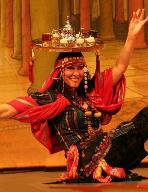About Seneeya (Tray)
Below you will find information on dancing with a tray in Middle Eastern folkloric dances and Bellydance.
Balancing things on ones head has been a traditional part of daily life for women throughout North Africa, the Mediterranean, the Middle East, and South West Asia. Learning this skill made carrying water, food, and other goods easier either providing more space to carry more items or by freeing up ones hands for other important tasks. Because this is so common to the traditional lives of people in these regions various folk dances have evolved that showcase a persons skill at balancing or present this part of daily life through dance or entertainment.
Raqs as-Seneeya (رقص الصنية) developed in Morocco. It is unknown just how old the practice is but? it is believed that it developed out of the Moroccan Tea Ceremony. In Morocco (as in many parts of North Africa and the Middle East) tea is a very important staple of life. It is not just a drink but something you do. Tea means entertaining guests, talking with friends or family and engaging in long standing tradition. Moroccans are especially well known for their mint tea and like the rest of the region is known for showing guests a great deal of hospitality.
The Tea ceremony itself is generally done right in front of the guests. First some green tea (also called Gun Powder) is put in a teapot. Then boiling water is added to the pot and about one cup is poured out and saved for later. They call this cup the "spirit" or essence of the the tea. It is a reddish brown color. Then they fill the pot with some water and stir it by shaking the pot. This is the rinsing of the green tea. The water is poured out and discarded. This will be a blackish color and is said to be bad for the stomach. The rinsing will generally be done at least twice until the color of the tea is reddish like the original "spirit." When the right color is achieved then the pot is filled about three quarters of the way with boiling water and the "spirit" of the tea (which was set aside) is poured back in. After this a handful of fresh mint sprigs are folded in half and twisted ripping the leaves. They are then placed in the pot (all bunched up in a twisted ball). Then a cone of hard cane sugar is brought out and a large pestle is used to crack it into pieces. Once broken up several large chunks of sugar are added to the pot. At this point the tea is left to steep for a few minutes during which the host will usually tell an entertaining story or provide some other entertainment. Once the tea has had some time to steep and the sugar dissolves two glasses are poured out and then returned to the pot. This mixes the tea and gives it more uniform taste and sweetness. After this the tea is ready to be poured and drunk by the guests.
In traditional Seneeya the tray has a pot full of hot tea and empty glasses. Once the dance is done the tea is immediately poured and served making this a likely development as a way to pass the time while waiting for the tea to steep and in lieu of an entertaining story or anecdote. Most dances take about 3-5 minutes which is the perfect amount of time for the tea to be ready. This type of entertainment became especially popular in tea and coffee houses where it is generally performed by men.
Traditional Seneeya is not just Bellydancing with a tray on the head it is an athletic display of strength and flexibility. The performer will utilize movements such as the splits and backbends as well as lifting both feet and arms to balance on the butt or stomach alone as well as a variety of other movements that demonstrate these qualities. Pelvic isolations in floorwork are also common and much of the floor section is spent turning around either in a rolling fashion or a kneel and sit sort of variation with pelvic or torso isolations at each interval. When standing the movements are comparable to Moroccan Shikhat featuring largely the same movement vocabulary and general usage.
The dance has gained a great deal of popularity and has evolved both inside and outside of Morocco into a performance piece done in a full Bellydance bedlah and in a Raqs Sharqi style and context. Dancers in these performances generally do not have tea in the pot (sometimes they don't even have a pot) and often put small lighted candles in the cups making it almost like a Moroccan styled Shamadan dance. It is not uncommon to find this newer style in tourist areas of Morocco where the unknowing viewer is told this is a traditional dance. This newer style of Seneeya has even been featured on shows such as 'Top Model' and 'Jessica Simpson's The Price of Beauty'. It is also the most commonly seen performance of Seneeya in Western raqs performances. It is performed by both men and women in both folkloric and modern styles.

